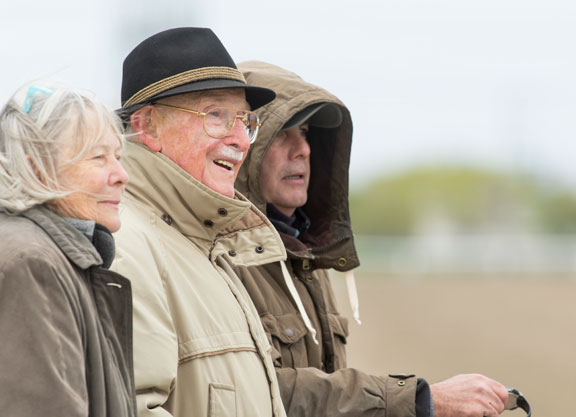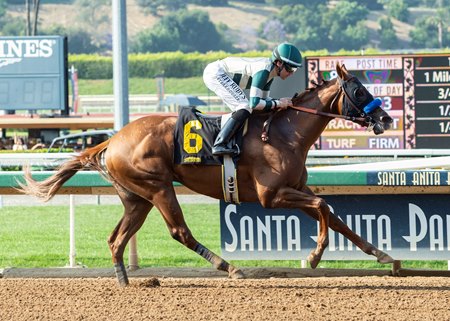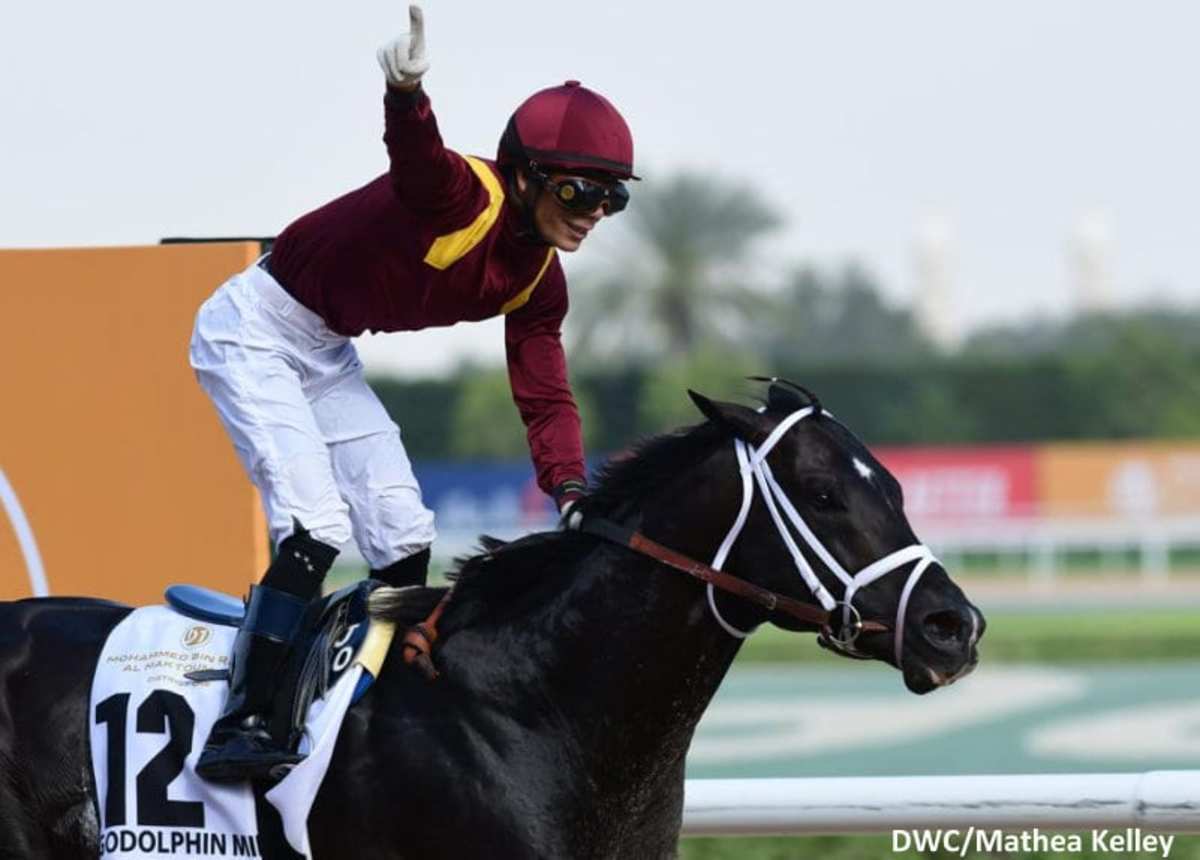COURTESY OF THE TDN

Gus Schickedanz with his longtime trainer Mike Keogh | Dave Landry
By Kelsey Riley
Gustav Schickedanz, a leading owner/breeder in Canada, foxhunting enthusiast and construction magnate, died peacefully on June 17 aged 90 at his home in Schomberg, Ontario, with his family by his side.
What Gus achieved in the Thoroughbred business, with a broodmare band rarely totaling more than 20, was truly remarkable. His pride and joy was his homebred sire Langfuhr (Danzig), who in 1996 won the GI Vosburgh S. and GII Forego H., and in 1997 the GI Carter H. and the GI Met Mile. Langfuhr, standing first at Vinery and later at Lane’s End where he is today pensioned at age 26, would carve out a reputation as a reliable sire of runners over all surfaces and across all distances, his Grade I winners including Whitney H. and Woodward S. winner Lawyer Ron, Arlington Million and Gulfstream Park Turf S. winner Jambalaya and Beldame S. and Gazelle H. winner Imperial Gesture.
Gus’s entire program was built on cultivating his own families and using predominantly his homebred stallions, and thus it is no surprise Langfuhr would go on to be the linchpin of his breeding program in the 21st century. Such a strategy gave Gus Wando, the 2003 Canadian Triple Crown winner and Horse of the Year; 11-time stakes winner Mobil, GII Nijinsky S. winner Last Answer and dual Grade III and Canadian Classic winner Marlang. Gus bred Langfuhr from his own homebred mare Sweet Briar Too (Briartic), and he bred the dams of both Wando and Marlang as well. Last Answer, who won his stakes race at age seven, was the 14th and last foal out of Gus’s foundation broodmare Victorious Answer (Northern Answer), who he purchased in 1976 from Windfields Farm. Victorious Answer was Gus’s first stakes winner and produced two black-type winners, and her daughters and granddaughters produced a further 14 stakes winners. Last Answer, who won his stakes race at age seven and ran 44 times, perhaps embodies everything that Gus’s breeding program stands for: the belief in his own carefully nurtured families to produce tough, sound, classy athletes.
Other standouts bred and raced by Gus include the GII Monmouth Oaks winner (and Wando’s dam) Kathie’s Colleen (Woodman), 1999 Queen’s Plate winner Woodcarver (Woodman) and Canadian champion sprinter Glanmire (Briartic). He bred the only Canadian-bred winners of the Kentucky Oaks (Gal in a Ruckus, 1995) and Arlington Million (Jambalaya, 2007). Gus’s horses have earned 10 Sovereign Award trophies, and another testament to his homebred program is the fact that three of those were for Broodmare of the Year. Gus is a member of the Canadian Horse Racing Hall of Fame and in April he received one of Canadian racing’s highest honors, the Sovereign Award of Merit. In presenting Gus with his award, Glenn Sikura of Hill ‘n’ Dale Farm said, “Gus is a true horseman. This is a man that wakes up early to look at his horses. He lives on the farm with his family. He’s a master horseman and rider. He knows a horse from every stage. There is nothing this man can’t do that’s related to a horse.
“If you want the definition of a true homebred program you need look no further than at what Gus has done. The stallion he breeds to is his own stallion, and he breeds it to his mare that is out of another mare he bred and he races the offspring. Gus has been an absolute beacon for all of us.”
Gustav Schickedanz was beating the odds long before he entered the racing game. He was 15 when the Russians attacked his town in Germany in the midst of World War II in 1944 and, with his elders brothers in the army and his father ill, it was up to Gus to lead his family to safety. They all survived.
Six years later, with opportunities limited in war-torn Germany, Gus seized the opportunity to emigrate to Canada, the first country accepting German immigrants after the war. He arrived in July 12, 1950, with the clothes on his back, a toothbrush and $3 in his pocket. He found a job the following day laying bricks for a German contractor for $1.10 an hour and as he later recalled, “I was never unemployed.”
Gus’s elder brothers Gerhard and Kurt, as well as their cousin Dani, arrived in Toronto the following year and the quartet shared an apartment and worked as stonemasons and carpenters. In 1953 they incorporated their construction company Schickedanz Brothers.
Anyone who has ever spent time around Gus could attest to his devotion to family and his loyalty, and the fact that the Schickedanz’s were able to build an extremely successful business as a team and run it harmoniously for more than 60 years is a testament to those qualities. In a biography commissioned by the Schickedanzes in 2011 for family and friends, Gus explained that it was set out in the beginning that the running of Schickedanz Brothers would not be majority rule; all four had to agree on a decision to move it forward. With four stubborn German men at the helm this admittedly led to many a late-night deliberation, but in the end they all emerged on the same page. Today, Schickedanz Brothers owns land in the Greater Toronto Area and as far afield as British Columbia, Alberta, Florida and South Carolina. Shortly after the company was founded Gus married his wife, Ann, and they had four daughters: Lisa, Tina, Susi and Heidi.
Later, when Gus began to grow his breeding and racing operations, those same family values shone through not only in his dedication to his equine families but in his loyalty to his long-serving-and equally as loyal and hard-working-farm manager Lauri Kenny and trainer Mike Keogh. Kenny and Keogh are often described in racing circles as Gus’s “adoptive sons” and have been paramount in his racing success.
Gus, in Germany, had been on the backs of horses nearly from the time he could walk–“I believe I rode at age two and a half, bareback and barefoot,” he recalled-but his passion was set aside for his first decade in Canada to focus on building his business and his family. In 1960, he at last got back in the saddle with the purchase of a handful of Trakehner horses-this breed, originating from his homeland, would be Gus’s mount of choice for Foxhunting and carriage driving. Gus later kept a small string of Trakehners that shuttled between his farms in Ontario and South Carolina, and he rode every morning until well into his 80s. His faithful servants included the geldings Ethos and Kronprinz, and in 2006 he traveled to Germany and paid a record price at auction for Songline, a young Trakehner stallion in training who went on to be a very successful eventer.
In the early 1970s, Gus began buying well-bred fillies-the likes of Victorious Answer-to lay the foundation for his Thoroughbred empire. As Gus well knew himself he also needed the right land on which to nurture his athletes. In 1976 he purchased Longleaf Plantation near Aiken, South Carolina. A few years later followed the property he would dub Schonberg Farm in Schomberg, Ontario–Schonberg meaning ‘beautiful hill’ in German.
When it came to a Thoroughbred, Gus knew what he liked: the compact, strong type as opposed to the longer and leaner, with a short back with “just enough room for a saddle,” he’d often say. He had shares in Woodman and Clever Trick that served him extremely well. His most inspired splurge, however, would prove to be on a nomination to the booked-out Danzig at a Matchmaker auction at Fasig-Tipton in 1990. Gus selected his homebred stakes-winning filly Sweet Briar Too to use the nomination for her first mating, and the result was Langfuhr.
A foal of 1992, Langfuhr was the crown jewel of Gus’s best-ever crop of foals that also included Kathie’s Colleen and My Intended, who later foaled the Canadian champion 2-year-old filly My Vintage Port. Of 20 foals born at Schonberg Farm that year, 17 started, all were winners and seven were stakes winners. The next best individual crop was perhaps the 2000 group that yielded Langfuhr’s sons Wando and Mobil, between them the winners of 18 stakes races and almost $4.4-million. It was those two sons of his prized Langfuhr that pulled Gus back from the brink after a major health scare in 2001, when he suffered a series of strokes. Gus had a Richard Stone Reeves painting of Langfuhr that hung above the fireplace in his sitting room, and he once told me that he sometimes sat for hours and just studied it. When he passed through Lexington en route to South Carolina each winter, Gus would stop and spoil Langfuhr with a giant bag of carrots-the stallion grooms at Lane’s End will tell you the horse knew the sound of Gus’s voice.
Langfuhr, the tenacious, come-from-behind sprinter who went on to beat the odds year-after-year as a sire, perhaps embodied everything Gus had endured and accomplished in his own extraordinary life, and it was plainly obvious that the consummate horseman never once took that for granted.
I met Gus in the summer of 2004 when I was 15 years old on the Woodbine backside after stopping by to see my favorite horse, Wando, on the morning of a race day. I probably bombarded him with stats about his horse, and Gus told me to come back to the barn after the race and meet his wife Ann and farm manager Lauri Kenny. Wando didn’t win that day, but when my parents brought me back to the barn we found them in great spirits. Lauri invited me to visit Schonberg Farm, and I showed up about two weeks later. Lauri told me to give him a call if I was looking for a summer job the following year. I showed up for my first day of work the following fourth of July and, for the next four years, was at the farm just about every moment I wasn’t in class.
There are a few things I’ll never forget about Gus. Every morning, seven days a week, he walked down to the barn in a checkered shirt, blue jeans, black boots and a riding helmet, his dog Moby at his heels. He stopped en route to his morning ride to look at each mare and foal as they were turned out. He would then head on about a mile walk down to his barn of riding horses. As Gus aged and slowed down a little, he only started his walk earlier; he never drove to his morning ride.
Gus lived on the farm from the time he purchased it and he truly knew every building, every fence line and every tree. He often got down and dirty during big projects and he’d frequently drive the tractors and pull the wagons during haying season.
I remember Lauri telling me before I started that as a boss Gus was “tough, but fair,” and that couldn’t have been more true. He expected hard work, but if you delivered, he and Ann truly did treat you like family. When Ann took off for a drive around the farm she’d come armed with food for whoever she saw along the way. If she forgot, she’d turn around and return with something.
Gus’s positive attitude was infectious. When asked how he was, his response was almost always, “if I was any better, I wouldn’t know what to do.” He would grab your arm and squeeze it during conversation when he was excited, and sometimes slap you on the back so hard you’d lose your breath. Many a jockey surely suffered a bruised thigh when returning aboard a winner thanks to his exuberant slaps. On the contrary, if he lost, Gus was the ultimate sportsman. “That’s horse racing,” he would say, followed by his trademark, “amen.”
What Gus gave me is completely immeasurable. A massive leg up and education in the racing business, yes, but more importantly, memories that will last a lifetime and a second family that I remain very close with. Gus, you were the most incredible, inspiring, irreplaceable man. Today, I’ll raise a glass of Oban (and the other half) to you and say thank you. Amen.


